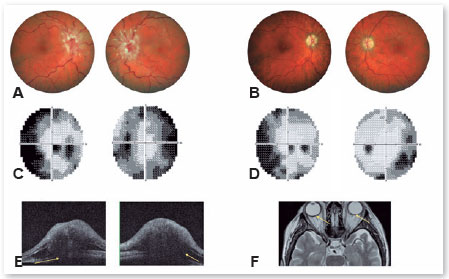Glauco Batista Almeida1; Mário Luiz Ribeiro Monteiro2; Leonardo Provetti Cunha3
DOI: 10.17545/eOftalmo/2023.0043
Este artigo pertence à Edição Especial Neuroftalmologia por imagem: acima e além
Idiopathic intracranial hypertension (IIH) is a significant cause of papilledema, which is diagnosed based on ophthalmological evaluation, neuroimaging studies, and intracranial hypertension (>25cmH2O) on lumbar puncture1. IIH is usually associated with weight gain and should be differentiated from other conditions that cause intracranial hypertension, such as intracranial tumors, certain medications (e.g., tetracycline), and abnormalities in the cerebrospinal fluid (CSF) drainage system1. Accordingly, IIH treatment involves medications that reduce intracranial hypertension and weight2.
The following findings were compatible with IIH: CSF opening pressure of 70 cmH2O on lumbar puncture, visual field constriction, optic disk swelling on fundus examination and optical coherence tomography (OCT), and flattening of the posterior ocular globe on OCT or magnetic resonance imaging (Figure 1).

The treatment comprised acetazolamide (250mg six times a day) and weight reduction measures (body mass index was reduced from 42 to 35kg/m2). Post-treatment lumbar puncture revealed a CSF pressure of 24cmH2O with concomitant anatomical and functional improvement in the optic nerve (Figure 1).
REFERENCES
1. Chen JJ, Bhatti MT. Papilledema. Int Ophthalmol Clin. 2019; 59(3):3-22.
2. Sinclair AJ, Burdon MA, Nightingale PG, Ball AK, Good P, Matthews TD, et al. Low energy diet and intracranial pressure in women with idiopathic intracranial hypertension: prospective cohort study. BMJ. 2010 Kul 7:341:c2701.
| AUTHORS INFORMATIONS | |
 |
» Glauco B. Almeida http://lattes.cnpq.br/2117165254457635 https://orcid.org/0000-0002-0036-1223 |
 |
» Mario Luis R. Monteiro http://lattes.cnpq.br/2835897475180267 https://orcid.org/0000-0002-7281-2791 |
 |
» Leonardo Provetti http://lattes.cnpq.br/6107543569545222 https://orcid.org/0000-0001-7984-1790 |
Funding: No specific financial support was available for this study.
Conflict of interest: None of the authors have any potential conflict of interest to disclose.
Received on:
May 5, 2023.
Accepted on:
July 24, 2023.